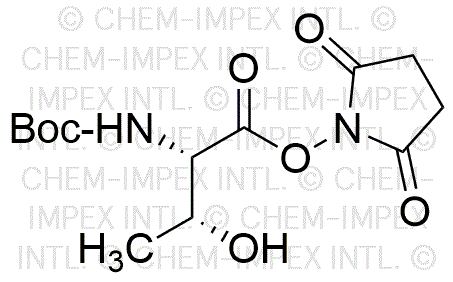Boc-L-threonine N-hydroxysuccinimide ester is widely utilized in research focused on:
- Peptide Synthesis: This compound serves as a valuable building block in the synthesis of peptides, particularly in the pharmaceutical industry, where it aids in the development of therapeutic proteins and vaccines.
- Bioconjugation: It is commonly used in bioconjugation processes, allowing researchers to attach biomolecules to surfaces or other molecules, enhancing the functionality of diagnostics and drug delivery systems.
- Drug Development: The compound plays a crucial role in the design of prodrugs, which improve the solubility and bioavailability of active pharmaceutical ingredients, making them more effective in clinical applications.
- Research in Protein Engineering: Its application in protein engineering helps in modifying proteins to study their functions or improve their properties, which is essential in biotechnology and enzyme development.
- Diagnostic Applications: The ester is utilized in the development of diagnostic assays, where it can improve the specificity and sensitivity of tests, benefiting fields like medical diagnostics and environmental monitoring.
General Information
Properties
Safety and Regulations
Applications
Boc-L-threonine N-hydroxysuccinimide ester is widely utilized in research focused on:
- Peptide Synthesis: This compound serves as a valuable building block in the synthesis of peptides, particularly in the pharmaceutical industry, where it aids in the development of therapeutic proteins and vaccines.
- Bioconjugation: It is commonly used in bioconjugation processes, allowing researchers to attach biomolecules to surfaces or other molecules, enhancing the functionality of diagnostics and drug delivery systems.
- Drug Development: The compound plays a crucial role in the design of prodrugs, which improve the solubility and bioavailability of active pharmaceutical ingredients, making them more effective in clinical applications.
- Research in Protein Engineering: Its application in protein engineering helps in modifying proteins to study their functions or improve their properties, which is essential in biotechnology and enzyme development.
- Diagnostic Applications: The ester is utilized in the development of diagnostic assays, where it can improve the specificity and sensitivity of tests, benefiting fields like medical diagnostics and environmental monitoring.
Documents
Safety Data Sheets (SDS)
The SDS provides comprehensive safety information on handling, storage, and disposal of the product.
Product Specification (PS)
The PS provides a comprehensive breakdown of the product’s properties, including chemical composition, physical state, purity, and storage requirements. It also details acceptable quality ranges and the product's intended applications.
Certificates of Analysis (COA)
Search for Certificates of Analysis (COA) by entering the products Lot Number. Lot and Batch Numbers can be found on a product’s label following the words ‘Lot’ or ‘Batch’.
*Catalog Number
*Lot Number
Certificates Of Origin (COO)
This COO confirms the country where the product was manufactured, and also details the materials and components used in it and whether it is derived from natural, synthetic, or other specific sources. This certificate may be required for customs, trade, and regulatory compliance.
*Catalog Number
*Lot Number
Safety Data Sheets (SDS)
The SDS provides comprehensive safety information on handling, storage, and disposal of the product.
DownloadProduct Specification (PS)
The PS provides a comprehensive breakdown of the product’s properties, including chemical composition, physical state, purity, and storage requirements. It also details acceptable quality ranges and the product's intended applications.
DownloadCertificates of Analysis (COA)
Search for Certificates of Analysis (COA) by entering the products Lot Number. Lot and Batch Numbers can be found on a product’s label following the words ‘Lot’ or ‘Batch’.
*Catalog Number
*Lot Number
Certificates Of Origin (COO)
This COO confirms the country where the product was manufactured, and also details the materials and components used in it and whether it is derived from natural, synthetic, or other specific sources. This certificate may be required for customs, trade, and regulatory compliance.


